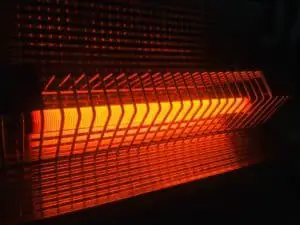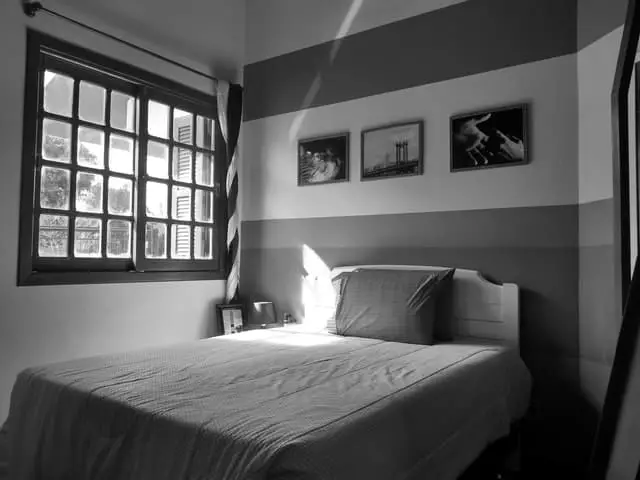Baseboard heaters bring the extra heat you need in spaces that require additional heating.
Such things as the size of electrical wiring and positioning can affect the functioning of the heater.
Also, you need to be wary about the materials you place close to the devices.
So, Can You Put A Bed Against A Baseboard Heater?
The answer is No because you have no good reason to sleep too close or to sleep right on top of the heater. You don’t even need to get too close to the heater to get maximum warmth. There are many reasons why it is not in your best interest to put the bed against the baseboard heater.
Five Reasons To NOT Put Your Bed Against The Baseboard Heater
Reason #1: Your Bed Could Be Warped or Your Beddings Could Be Ruined
Baseboard heaters generate heat. This is different from mini-splits which simply transfers heat. As a result of this feature, baseboard heaters need to be very hot to heat a room from their location on the baseboards.
This heat can be similar to what your oven generates. While the scalding heat may be exactly what you need in your room in the middle of the winter, it can turn out to be dangerous if you bring your bed too close to the device.
People have sustained burns and property burned by baseboard generated heat, as temperatures can rise to 150 degrees or more.
Because baseboard heaters are installed close to the floor, one or two of them will be beneath your bed where some of your beddings may be caught hanging.
Let’s say you are in the middle of the winter and you’re literally freezing. Sleeping at a healthy distance away from the hottest baseboard heater in your bedroom may deliver the results you want.
What could you possibly do to get the most out of the device?
Repositioning your bed to sit against the baseboard heater may do the trick, or so you might think. While the new position may increase the amount of heat reaching you, the proximity to heat can expose your bed and the beddings on it to damage.
Most beds are made from wood which is prone to warping when exposed to warm and cold colds in short periods.
In the long run, parts of your bed’s frame, especially those close to the heater, will start to develop slight deformation.
Depending on the material, parts of your beddings may be damaged by the sustained high temperatures.

Reason #2: You Risk Setting Your Beddings, And Your Whole Home, On Fire
According to the latest NFPA’s (United States Home Fires Involving Heating Equipment) report, heating equipment is the second-leading cause of home fires.
All heaters pose fire hazards to some extent, but putting some materials close to them can double the risk. That’s exactly what’s going to happen if you bring your bed close to the baseboard heater – you would have increased the likelihood of fires on your beddings.
Nobody can promise you bringing the bed close to the baseboard heater will bring you all the warmth and health. It could probably end up exposing your whole home to a fire hazard.
First off, the amount of air wafting over the heater will reduce. This means more heat will linger around the heater and your beddings as there will be no element to push it around and away from the device.
If you choose to adjust the heater to produce more heat, there will be a significant risk of this heat taking a toll on your bedding in the underbelly of the bed and starting fires.
This can be more likely if some pieces of loose beddings or dry and flammable debris are beneath the bed close to the heater.
An extremely hot baseboard, say, something in the region of 100 degrees, can be a fire hazard because, by bringing the bed very close to the heater, you have flaunted the “6-inch rule”.
The most dreadful thing about furniture fires is that they tend to spread to items fast, eventually engulfing the whole home. If your bed is close to wall curtains, for instance, the fabric can spread the fire to the ceiling and then the roof.
If you must bring your bed too close to the baseboard heater, consider observing the “6-feet rule” – leave a 6-feet clearance between the bed and the heater.

Reason #3: You Will Be Obstructing the Rest of the Room from The Radiant Heat
First off, it doesn’t make sense to put your bed against the baseboard heater.
This arrangement can mean that much of the heat radiating from the heater ends up concentrated in a small area under your bed. This way, much of the remainder of the room will be deprived of heat.
The only time you could arrange your bedroom with the bed installed close to the baseboard heater is if the room were overcrowded that freeing an inch of space would mean everything. Still, a positioned against the wall will block much of the heat from warming the rest of the home.
Positioning the bed against the baseboard heater also means you are blocked from direct radiation from the device. Unless you climb down the bed and lie below the bed, you are really going to have a hard time receiving enough warmth from it in the winter.
Another problem that comes with obstruction is the overheating of the appliance. The obstruction prevents ample air circulation and around the device to aid in proper heat transfer through convection currents. Air deprivation can cause the heater to overheat and pose even a greater fire risk.
Reason #4: Its Plain Cost Ineffective
Another reason why it isn’t particularly a good idea to put your bed in a baseboard heater is the maintenance cost and possible wastage of heat energy.
Think about it – you won’t be utilizing the dissipated heat to the maximum because the bed is lying in the way. But since every joule of heat produced must be paid for, it means you will pay a huge sum of money on the heat you never used.
Baseboard heaters are 100 percent energy-efficient. Assuming that all the factors that affect the performance of the heater are constant – insulation, the wattage of the unit, hours of operation, quality of the structure of your home, and where you live – you still stand a chance of spending over 50 cents per day on wasted heat energy.
The daily cost of running a baseboard heater can be calculated by:
Formula: ((wattage x hrs. of use) / 1000) / electricity cost (rate for every kilo – watt/hr.)
For example, let’s say your unit is rated 2000-W, electricity cost in your area is $0.06, and the unit runs under your bed for 10 hrs. every day:
((2000 – Watts x 10 hrs.) / 1000 (w/kw) X $0.06 = $1.20 p / day
With a bed over your heater, there is a strong chance about a half of the $1.20 will go to waste, either because of the consequential energy-inefficiency or obstruction of the heat radiation.

Reason #5: You Be Reducing the Lifespan of Your Heater and Making Inefficient
Heaters last longer when they are used properly. Proper use and good maintenance include regularly wiping off the dust that often gets caught on the coils and vents and maintaining the recommended 6-feet clearance area.
However, putting the bed against the heater means this clearance area will be significantly reduced, causing the heater to overheat sometimes.
Also, reduction in clearance area means more dust and other debris will easily settle on the surface and coils. If the device is left to run in this state for a long period, the lifespan may reduce significantly – about 5 years off its projected lifespan.
Another consequence can be frequent breakdowns that may require a lot of money to repair. In the long run, the device can be too costly to run and necessitate a complete replacement.
The least you could expect from a baseboard heater is a reduction in efficiency because, as it’s traditional with electric heaters, they come 100 percent energy-efficient.
However, factors such as bad maintenance, misuse, and wrong installation can reduce this efficiency by about 20 – 30 percent depending on the extent.
If you put your bed against the heater, for example, you’re less likely to get the attention of the heater when it begins malfunctioning until the problem becomes more apparent, such as going off, bloated energy bills, or production of noises.
Yet these problems are often brought forth by the abandonment of the heater under your bed and accumulation of dust on the coils. Excess accumulation of dust particles on coils means the heater will need to use more electricity to heat them and deliver the heat that matches your temperature settings.
If you combine this dust and debris-induced inefficiency and the fact you are not utilizing all the heat due to obstruction by the bed, you may find yourself paying a king’s ransom to offset bloated energy bills.
Related: Can You Put a Refrigerator in Front of a Baseboard Heater?
Final Thoughts
In a nutshell, you have no good reason for bringing your bed too close to the baseboard heater, unless you want to cause obstruction and perhaps cause fires.
You might end up paying a hefty amount of money on energy bills as well.
Related: Is It Safe to Put a Bed Against an Electrical Outlet?

